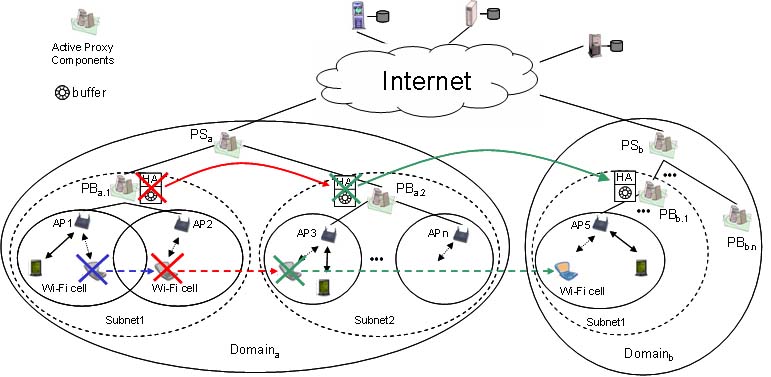Proactive HandoffOverviewNew deployment scenarios tend to consider the requirement of session continuity for service provisioning, especially multimedia streaming, to limited heterogeneous portable devices roaming among wireless localities. In particular, multimedia streaming should not experience any interruption while clients roam in wired-wireless integrated networks based on the standard best-effort Internet. The MUM approach aims to proactively overcome Wi-Fi handoff and maintain multimedia session continuity in the wireless Internet by exploiting mobile proxies running on the wired network. Mobile middleware proxies locally support resource-limited clients, avoid packet losses during handoffs, prefetch local buffers with multimedia contents before handoff occurrence. ArchitectureMUM exploits a proxy-based architecture to hide handoff occurrences and consequent data losses to mobile clients. Proxy-based solutions can also reduce client-to-server signaling during handoffs. Continuous services usually adopt connection-less protocols such as UDP, and manage data re-transmissions directly at the application level to react to high jitter and packet losses. In the fixed Internet, the deriving flow-control signaling is fairly limited and present only during network congestions/failures. On the contrary, Wi-Fi hard handoff causes relevant packet losses and is perceived as a network failure at the application level; in traditional multimedia systems, that may produce non-negligible client-to-server signaling and wrong perceptions of client situations at server side. Middleware proxies located at wired network edges close to their served wireless clients can split the direct client/server connection and significantly reduce both signaling traffic on the service path and QoS degradation at client. It is crucial to have mobile proxies that can follow client roaming at provision time to maintain co-locality with their supported devices during service sessions. Moreover, MUM distinguishes three main types of handoff:
The mobile proxy in charge of handoff management is called Handoff Agent (HA), and follows user movements by moving over the fixed network. Client-side data buffering is a common solution in streaming over wired networks to smooth possible congestions and packet losses along client-to-server paths. Nonetheless, we claim the unsuitability of traditional buffering, i.e., only pre-fetching chunks of multimedia flows at clients, to support multimedia continuity during Wi-Fi handoffs. Therefore, the HA hosts second level buffers that contribute to smooth handoff packet losses, without imposing too heavy data buffeing at clients.
|
